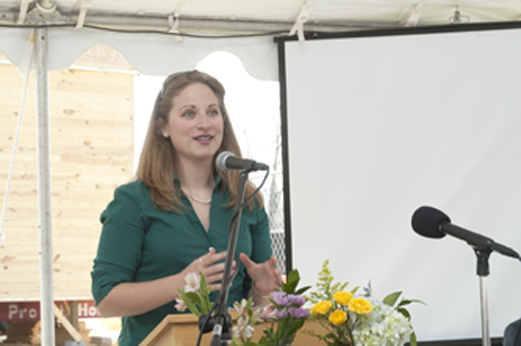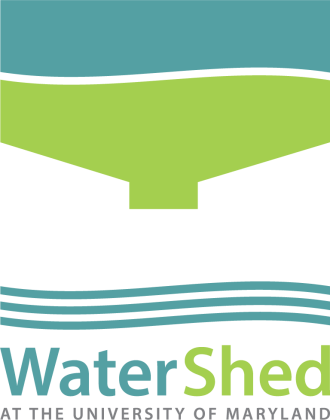
Allison Wilson, Team Leader, Presenting at ShedRaising
Photo Credit: Thai Nyugen
Allison Wilson doesn’t have a lot of free time on her hands. Since graduating with her Master of Architecture degree in May, she has started a new job with Ayers Saint Gross, a Baltimore-based architecture firm, while commuting regularly to the WaterShed construction site. It turns out that just because they give you a degree, doesn’t mean your work is done. And as Allison has been involved with WaterShed since day one, she has every intention of seeing it through.
Serving as Primary Student Contact, Allison – who is originally from Randolph, New Jersey – spends a lot of time on the construction site, wearing many hats. Architecture. Project Management. Construction. Communications. Staging. Outreach. Public relations. Fundraising. Project manual. Competition strategy. She is a catch-all, and her resume is extensive. She has found many rewards from her time on WaterShed; new friends, new skills, and a new job. Allison explains all of this- and what she hopes people take away from WaterShed – below.
What has been your personal WaterShed moment so far?
AW: My most rewarding moments have been sharing our house with kids. When we’ve done outreach events for the public such as Maryland Day, there’s been nothing more fun than showing kids what their imaginations can do when they grow up a little bit. The project itself can be complicated and stressful, but talking to kids is a huge stress-reliever. They are so accepting of WaterShed’s narrative; they look at it and basically see a big doll house. I think since it’s a small house, it feels more on their scale.
What did you most want to learn by being a part of WaterShed?
AW: I most wanted to learn what my drawings actually meant. I spent six years going through undergrad and grad school at Maryland and I got a good handle on how to design a building and how to represent my ideas verbally and graphically, but it never clicked for me how a building actually gets put together – no matter how many wall sections I drew, I just couldn’t get it. Building WaterShed and seeing the layers of a building come together and how they get fastened and why things happen in a certain order has been really rewarding for me. I can now say I have a much better handle on how the drawings we make as architects actually get a building built the way we intend it to be.
What’s an aspect of the project you value most?
AW: The best part of WaterShed is getting to work with people other than my studio classmates who I see every day. Getting the chance to work with all the different engineers, mentors, and environmental science students has rounded out my sustainable education, giving me a broad-based understanding of how to make better buildings. Architecture is so much bigger than architects, and if we’re going to achieve a sustainable future, we need to be crossing industry lines.
There are literally hundreds of heroes on this team who have saved the day in countless ways. My teammates have stepped up to the plate with both pre-existing knowledge and the ability to quickly learn new things in a way that amazes me. Beyond the team-related things, it’s great to know that we’re friends too. We come out to watch each other’s thesis presentations, celebrate birthdays, go to concerts and sports games, and hang out on Friday nights. Our greatest success is designing and building a house on a very tight schedule and still wanting to be friends at the end of the process.
Has working on WaterShed influenced your career path?
AW: WaterShed helped me get my first professional job after graduation. We pitched WaterShed to Ayers Saint Gross, a Baltimore-based architecture and planning firm, in December looking for sponsorship. At the end of the meeting, not only had they bought into supporting WaterShed and its mission to educate the public about the relationship between buildings and water, but I had also convinced them to interview me for a position following graduation. My interview in early spring was successful, and since I graduated in May I’ve been simultaneously working at Ayers Saint Gross in Baltimore and working on completing WaterShed.
When people come to visit WaterShed on the Mall in September, what do you hope they will take away from the experience?
AW: I hope WaterShed teaches people that they have the power to change the way their built environment impacts the natural world. We’re surrounded by decisions every day – everything from how our doors work to what a can opener looks like – and most people take that at face value as the way things should be. WaterShed shows that all of those decisions make an impact on our environment and hopefully people who visit will be a little more aware of what their decisions mean to our planet.
What do you always have with you on the job site?
AW: I always have my pink hardhat and my pink tools which were Christmas gifts from my parents. It’s been kind of awesome for them because my mom and dad watch the webcam and can always find me because I’m the only one on site walking around in a pink hardhat.
How do you spend your time when you’re not on the job site?
AW: Trying to fix my heinous construction tan lines. The T-shirt tan is not my favorite look, so when I get a chance it’s really nice to be outside enjoying the sunshine.
